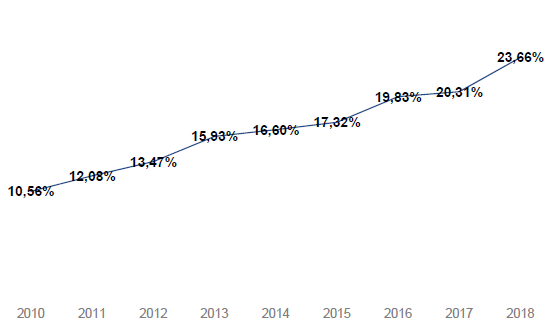Slow Progress For Women On Spanish Boards
By IESE Insight
Women’s representation on the boards of Spain’s listed companies climbed by 15 percent during the year 2017. That increase brought the total to 258 female directors, who now occupy just over 19 percent of 1,347 board seats.
While significant ground was gained, the current situation still falls short of the 30 percent representation recommended by the Good Governance Code of Spain’s National Securities Market Commission (CNMV) for the year 2020.
This is made clear in a new report on women on the boards of Spanish listed companies, created under the academic direction of professor Nuria Chinchilla, holder of the Carmina Roca and Rafael-Pich Aguilera Women and Leadership Chair at IESE.
The report, produced by communications consultancy Atrevia and IESE, includes the first annual analysis of Spain’s continuous market and the sixth annual report on women on the IBEX 35 boards of directors.
Much Remains to Be Done
According to the study, there are 15 listed companies without any female directors and another 47 have only one woman on the board. This means that almost half Spain’s publicly traded companies still have minimal or no female presence in positions of corporate oversight.
What’s more, the advance of women in absolute numbers and their relative weight on corporate boards does not translate into a significant increase in executive positions. In fact, less than 5 percent are executive directors.
Companies in the financial sector have the most female presence on their boards — an average of three female directors per company. The fewest are found in real estate services — with only one woman, on average, occupying a board seat.
IBEX-35 Companies: Ahead of the Curve
Homing in the 35 companies tracked by Spain’s benchmark IBEX-35 index, and setting aside the remaining 98 listed companies, more progress is seen. In the elite group of 35, there are 106 female directors out of 448 total — that’s almost 24 percent. In the other listed companies, female representation comes to just about 17 percent.
And, as for the number of female directors per company, the IBEX 35 has, on average, almost double the number seen for the rest of Spain’s stock market participants. That said, the only two companies with more female than male directors — Realia and Ezentis — are not IBEX-35 components.
For the first time, all 35 IBEX-tracked companies have some female representation and there’s upward trajectory apparent: as of the beginning of February, there were 106 female directors, 14 more than counted by the fifth annual report on IBEX 35 companies.
With regard to the relative weight of women in the IBEX boards, the current 24 percent is nearly double the 12 percent tallied just seven years ago, in 2011.

The signs of improvement in the IBEX 35 are evident: last year, 12 companies appointed more women and now eight of them (four more than last year) are in line with the European Commission’s recommendation that at least 40 percent of non-executive directors should be women.
According to the report, four women CEOs also chair their boards — one more than the previous year. They are Ana Botín of Santander, María Dolores Dancausa of Bankinter, Vanisha Mittal of ArcelorMittal, and now Cristina Ruiz of Indra.
Closer To Europe
The listed companies of Spain are coming closer to European averages — although, at 19 percent, they are still 6 percentage points below the European Union’s large listed companies, where one out of every four board members is female. The gap between the IBEX 35 and EU average is much smaller, at just 2 percentage points (see graphic below).
In terms of the situation in other countries, the European Commission’s 2017 Report on Equality between Women and Men in the EU shows that female representation on boards of large listed companies is led by France (41 percent), Sweden (37 percent) and Italy (32 percent).
Methodology, Very Briefly
The report analyzes female representation on the boards of 133 listed companies on Spain’s continuous market (i.e., its stock exchanges traded simultaneously in Madrid, Bilbao, Barcelona and Valencia). The principal data for the IBEX-35 companies were updated on February 8, 2018, while the rest of the data were collected on January 22, 2018. The data comes from Spain’s National Securities Market Commission (CNMV) and the websites of the listed companies.

